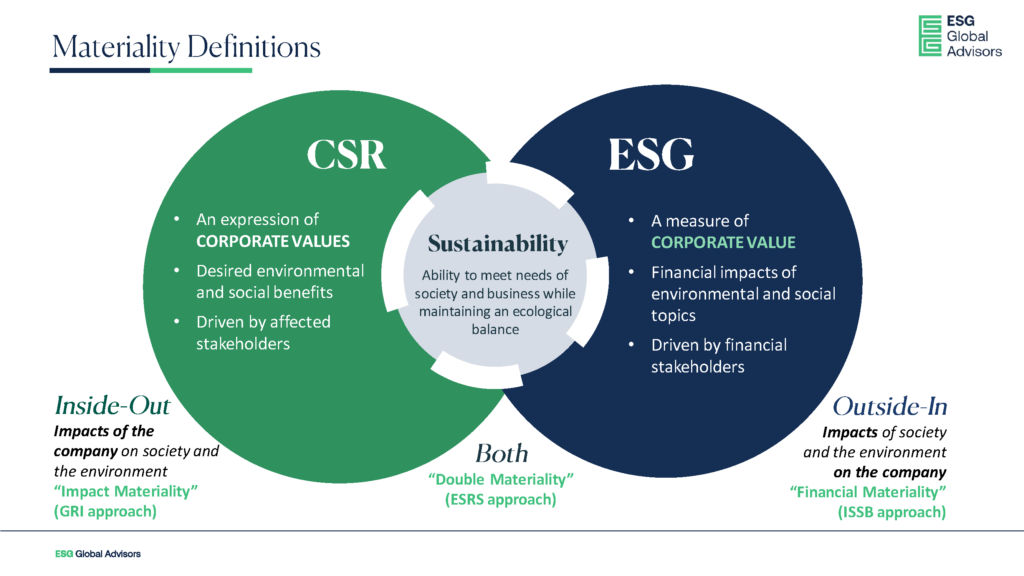Office
First Canadian Place
100 King Street West
Suite 5600
Toronto, Ontario
M5X 1C9
Canada

By Alison Joutsi, Principal, ESG Global Advisors
Keeping up with all of the ever-evolving frameworks, best practices, and related concepts is one of biggest challenges for ESG and sustainability professionals. Double materiality assessments are among the newer practices that companies need to understand. This article explains the concept of double materiality and why it matters in the context of regulatory developments. It concludes with five actions corporate issuers can take to position themselves for success as double materiality gains traction in the sustainability reporting landscape.
The concept of a materiality assessment is not new to capital markets. It is the process by which a reporting company determines what ESG issues are the most material or important from a financial perspective. From a financial perspective, an issue is considered material if it triggers or could reasonably be expected to trigger material financial effects on the entity. For example, when a sustainability matter, such as biodiversity, generates an effect on a company’s balance sheet, growth strategy or access to capital over the short, medium and long-term it is considered to have a financial impact. This is why organization’s should seek input from investors, lenders, credit rating agencies and regulators when performing this assessment.
Material ESG topics identified during an assessment, such as emissions management, ethical behaviour, and diversity, equity and inclusion, provide important context for communicating financial risks and value creation opportunities that an entity could face over the short, medium or long-term. This is the connection between ESG reporting and financial reporting. Material ESG-related risks and opportunities may impact an organization’s financial statements, if not properly managed. Therefore, companies are better able to identify and address potential risks, improve decision-making, and enhance long-term value creation by incorporating ESG reporting within its financial reports.
This is often referred to as “single materiality1” or “outside in” referring to the impact of ESG issues solely on a company’s financial and operational performance and long-term value creation. For example, a gold mining company might identify health and safety as a material financial issue for the organization. From a risk perspective, if the company fails to manage the health and safety of its workforce, it may face lawsuits, reputational damage and will be unable to attract and retain a qualified workforce. These issues will have a negative impact on its cashflow, access to and cost of capital, and prospects if not properly managed. However, there are also opportunities, such as utilizing various technological innovations and implementing health and safety training programs that can lead to positive outcomes and increased value creation opportunities.
In order to make strategic capital allocation decisions, stakeholders and investors now expect companies to conduct a financial materiality assessment as a foundational component to their ESG reporting practices.
The introduction of the Corporate Sustainability Reporting Directive (CSRD) has brought a new dimension to the materiality assessment, namely the “double materiality” assessment. In other words, the CSRD asks companies to also evaluate their impacts on the environment and society.
It’s important to note the distinction between the terms “ESG” and “Sustainability.” The term “ESG” is used to refer to financial materiality, or the effects of environmental, social and governance issues on a company’s financial statements. Whereas “sustainability” is commonly used to refer to the ability of an organization to meet the needs of society and business, while maintaining an ecological balance. The EU regulation uses the term “sustainability” to refer to both “financial materiality” and “impact materiality.”
Double materiality encompasses the two dimensions outlined above: impact materiality and financial materiality. This new concept looks at how sustainability issues, whether they are actual or potential, affect a company’s financial position (i.e., “outside in”), along with how the entity impacts the environment and society (i.e., “inside out”). The diagram below further illustrates this concept.

A sustainability issue is considered material from an impact perspective when it relates to an entity’s actual or potential, positive or negative, impact on people or the environment through its products, services and its business relationships over the short, medium or long-term. These issues are a consequence of the company’s operations, products and services, including its value chain. An important component of impact materiality includes both the likelihood and severity of an impact.
When assessing impact materiality, an organization needs to look at a variety of factors, that could include the actual or potential negative impacts, as well as the actual or potential positive impacts. To identify these factors, in-depth stakeholder engagement is required. This is an important input to an impact materiality assessment, as the reporting company is required to engage with its internal and external stakeholders to identify and understand its impacts, risks and opportunities.
This requires input from a reporting entity’s affected stakeholders, such as employees, suppliers, customers, and local communities that could be affected – positively or negatively, by the organization’s activities, along with direct and indirect business relationships across its value chain. Stakeholders also include users of the sustainability statement, including existing and potential investors, lenders and other creditors, to name a few.
A sustainably matter is material from a double materiality perspective if it meets the criteria defined for either impact materiality or financial materiality.
The CSRD amends the Non-Financial Reporting Directive (NFRD) and enhances the sustainability reporting requirements for companies falling within its scope. If an entity is within the scope of the CSRD, it must comply with both the EU Taxonomy and the European Sustainability Reporting Standards (ESRS). In the EU alone, it is expected that more that 50,000 companies will be implicated by the new reporting requirements, with some companies needing to report as early as 2025. Furthermore, there are reporting implications for an estimated 10,300 non-EU based companies, including about 1,300 based in Canada and 3,200 in the United States.
While the above estimates provide a general idea of how many companies will be affected by the CSRD, the scoping analysis of who needs to comply is complex. Legal advice should be sought to determine whether a company is in scope, as there are different scoping requirements for companies located in the EU, EU-listed companies, and non-EU parent companies.
General scoping under the CSRD depends on size or listed status. Whereas non-EU parent requirements are based on physical presence in the EU and revenue generated in the EU, as outlined below.
The CSRD applies to all large and most listed companies in the EU, including their subsidiaries. Companies outside the EU with securities listed on an EU-regulated market must also comply with the CSRD.
Must meet two of the following, for each of the last two consecutive years:
Non-EU companies that meet the criteria listed below must also comply with the CSRD:
It is important to note that limited assurance over the entire sustainability report, including the double materiality process used to identify the information reported on, for both the general and non-EU company scoping is required.
This shift to double materiality is important to effectively address systemic risk, making it important for many reasons. While single materiality does not look at a company’s impact on the environment and society at large, this approach can lead to misleading statements overall, including accusations of greenwashing, in relation to how a company holistically manages sustainably issues. Furthermore, a lack of consideration of “inside out” impacts on the environment and society won’t adequately address the underlying issues creating these systemic financial risks, such as climate change. Therefore, it is highly relevant to look at both as they are interconnected and mutually reinforcing.
From a regulatory perspective, conducting a double materiality assessment is the starting point for reporting under the CSRD. Companies that meet the required thresholds will need to conduct a double materiality assessment to identify all material impacts, risks and opportunities, and disclose the outcome of this process, and the methodology used to determine the material information. It is also important to note that Canadian issuers are starting to consider double materiality assessments as the gold standard. Millani’s 7th Annual ESG Disclosure Study: A Canadian Perspective found that recent regulations and best practices have driven 19% of Canadian issuers conducting materiality assessments to adopt a double materiality perspective, covering both financial materiality and impact materiality dimensions when reporting to multiple audiences.
The reporting requirements under the CSRD, along with the double materiality assessment, should signal to the market that mandated sustainability reporting is not going away. In fact, it is likely only going to become more complex.
Here are five actions companies can take to position themselves for success as double materiality gains traction around the world:
Additionally, if your corporate growth strategy involves plans to expand into the EU, it is important to begin to embed sustainability principles into your business model to ensure that you are competitive and positioned for long-term success.
Contact us to learn more about ESG Global Advisors, our team, and how we can help you with your approach to reporting under the CSRD. ESG Global offers a comprehensive range of ESG services for companies and investors. Visit Our Services to learn more.
Disclaimer: Please note that the content and material provided in this article is for general information purposes only. It is not to be taken or relied upon as legal advice and should not be used for professional or commercial purposes. This article is intended to communicate general information about relevant sustainably matters and reporting requirements as of the indicated date. The content is subject to change based on evolving regulatory reporting requirements.